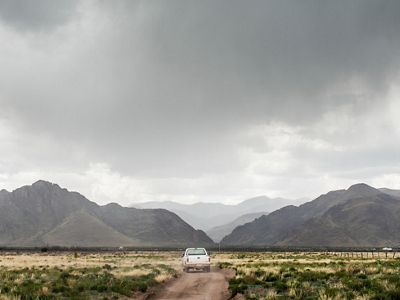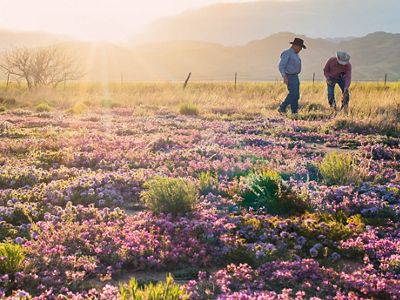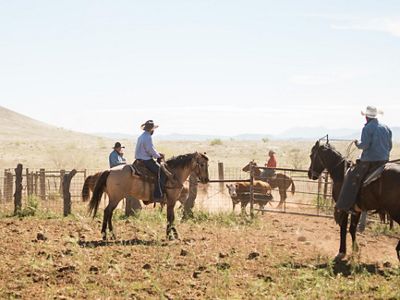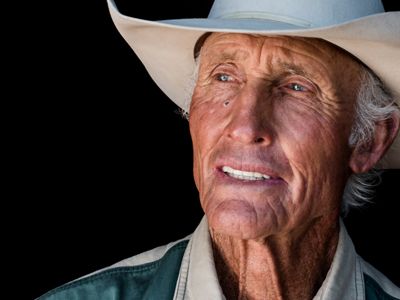
New Life in the Badlands
In the Malpai Borderlands region of southern Arizona and New Mexico, ranchers and conservationists have joined forces to protect a unique landscape.
By Scott McMillion, Freelance Writer | October/November 2015
Most mornings, Warner Glenn is in the saddle by the time the sun rises on his Malpai Ranch, tucked away in Arizona’s southeastern corner. At 79, Glenn stands about 6 feet 5 inches, as straight as an arrow and just about that big around, deeply tanned from a life in the desert. He likes to bring his Walker hounds along so that they can exercise their legs, their lungs, their noses. When he leaves them behind, they put up quite a racket. “They think I forgot something,” Glenn shouts above the howling one March morning, the heat already building.
Glenn points his horse uphill toward the Peloncillo Mountains, picking through the agave and prickly pear, and through the jagged volcanic rock—the malpai that gives his ranch its name. On one hilltop, he points to a rectangle of stones about the size of a coffin where his dogs recently sniffed out a man hiding with binoculars and a cellphone—probably a drug smuggler, he says. Such encounters aren’t unusual in a region known as the Malpai Borderlands, where Arizona and New Mexico bump into each other atop the Mexican border.
It’s a hard place, a land that requires wisdom and strength if a person wants to make a living from it. But it’s also an achingly beautiful place. Two mountain systems and two deserts converge here, funneling vast diversity into roughly a million acres: dozens of butterfly species, 295 kinds of birds, some 4,000 plant species. Glenn has even twice spotted a jaguar—some of the only North American sightings of the animal in decades.
“The fact they’re showing up every once in a while tells us we’re doing something right, here and in Mexico,” he says, adding that he’s hoping to see another jaguar this year.
It’s not exactly typical to hear a livestock rancher rejoicing about carnivores on his turf. But Glenn and his neighbors in the Malpai Borderlands aren’t interested in typical. They’re interested in keeping this place alive.

Cattle ranching has been about the only way to earn a living in these desert grasslands since the late 1800s, when overgrazing caused some seriously long-lasting damage to the land. But by the 1990s, many a rancher in the West felt as though he had a bulls-eye on his back despite improving range conditions. “Cattle Free by ’93” had become a rallying cry for thousands of people who were concerned about the impact of ranching in the arid West. They were persuasive and well lawyered, and they wanted to see all cattle removed from public lands. Needless to say, ranchers and environmentalists didn’t share much time over a cup of coffee.
Therefore, many Malpai ranchers were understandably edgy when, in 1990, The Nature Conservancy suddenly became their largest neighbor. The Conservancy’s $18 million purchase of the Gray Ranch was touted as the largest single private conservation acquisition in U.S. history.
Sprawling across the boot heel of New Mexico, the Gray Ranch was 502 square miles—slightly larger than Los Angeles at the time—of ecological splendor. Over the course of a century, the ranch had been owned partly by the wealthy Hearst family, then by a series of corporate owners before Mexican investor Pablo Brenner acquired it in the early 1980s. This unique, largely intact landscape had been identified as a priority by the Conservancy’s team of scientists. So when Brenner decided to sell, the Conservancy jumped.
Most people expected the organization to create a preserve or to transfer the land to be protected by the federal government, as it had often done in the past. It was no secret that the Conservancy had begun negotiations with the U.S. Fish and Wildlife Service, which planned to turn the land into a wildlife refuge—named for the Animas Mountains, which were almost entirely encompassed by the property—and remove all the cattle.
“I was ready to go to work on the Animas National Wildlife Refuge,” recalls Bill Radke, a Fish and Wildlife Service ecologist and wildlife refuge manager.
But the neighboring ranchers lobbied hard against the idea of the land becoming public and cattle free. It would hurt the local tax base, they said, and convey a negative message about ranching in general. There was dissension inside the Conservancy as well. Biologist Ben Brown, who at that time was running all of the Conservancy’s science programs in the western United States, argued that selling to the government “would do nothing but cement our reputation as the real estate arm of the U.S. Fish and Wildlife Service.”
What happened next turned just about everyone’s head: After then-Secretary of the Interior Manuel Lujan said he wouldn’t agree to a Fish and Wildlife purchase, the Conservancy announced that it was selling the Gray Ranch anyway. But not to a government agency. To a rancher.

It took a while to work out the details, but in 1993, the Conservancy sold the Gray Ranch to the Animas Foundation—newly created by rancher Drummond Hadley and his family—under a conservation easement that banned development but allowed traditional livestock ranching to continue.
That’s when fifth-generation Malpai rancher Bill McDonald decided it was time to meet the neighbors. He called John Cook, then the Conservancy’s lead negotiator, who had been tasked with figuring out how to ensure the conservation of the Gray Ranch lands while recouping some of the $18 million purchase price.
“Bill McDonald called me and said, ‘You don’t know me, but I know all about you,’” Cook recalls more than 20 years later, sitting at Warner Glenn’s table. The men agreed to meet at McDonald’s ranch, where they both saddled up.
Adds Cook, “We clomped around all day and we didn’t see a soul,” as McDonald pointed out public and private ownership boundaries that had nothing to do with ecological function. “That’s when I realized these guys were really interested in maintaining the landscape in a healthy way. And they were inviting us in. It was an incredible opportunity.”
Cook spent the next several years cementing a relationship between the Conservancy and the ranchers—helping them learn about conservation, negotiate bureaucracy and base land-management decisions on sound science.
“Ranchers as environmentalists,” says Cook. “That was all new back then.”

The Malpai Borderlands Group traces its roots back to 1991, when a fire broke out just west of Glenn’s ranch, along the Geronimo Trail, a dusty track that twists its way to the border town of Douglas, Arizona. Most of the local ranchers understood the ecological importance of fire. They knew that without periodic flames, woody shrubs such as mesquite would choke out the grasses cattle and wildlife needed.
When Glenn and his daughter and ranching partner, Kelly Glenn-Kimbro, saw the smoke, they raced to the scene, but they agreed with a neighbor that the land needed to burn. Then the Forest Service showed up and put the fire out, even though it threatened no structures and offered what looked to many of the ranchers like obvious benefits.
But dousing the flames sparked something else: the first stirrings of the Malpai Borderlands Group, an unlikely coalition that got its start at Glenn’s ranch. That’s where some lifelong cattle ranchers decided to listen to a man named Jim Corbett, a Quaker philosopher from Harvard who thought there might be a way to get beyond the long-standing rancor between ranchers and environmentalists.
So did Drum Hadley, the soon-to-be owner of the Gray Ranch. Hadley was an heir to the Anheuser-Busch fortune, but he was also a bona fide rancher who as a young man had worked cattle on both sides of the border. A respected poet, he had many friends in literary and environmental circles who thought cattle grazing in arid regions was a bad idea. He encouraged them to meet with his ranching neighbors,people like McDonald and Glenn, and take a close look at the land they were arguing about. A couple months after the fire, a meeting was arranged in Glenn’s barn.
“I didn’t think anything would come of it,” McDonald says. But he was happy to be proved wrong. They realized that they all wanted to protect open space. A consensus began to emerge about the relationship between ranching and fire. The meetings continued, facilitated by Corbett. Officials from the federal and state governments attended, as did local fire departments, who learned that they could be paid to monitor a fire, just as they are to fight one. Scientific specialists in rare species, plants and water got involved.
The ranchers decided they needed a formal organization based on the premises that wildlife and livestock could coexist; that economically viable ranching was the best way to preserve open space; and that ranchers, environmentalists and government agencies could learn to get along. Trying to articulate his goals, McDonald coined a phrase: This was “the radical center.” By 1994, the Malpai Borderlands Group was established as a nonprofit, with Glenn among its founding members and McDonald as executive director.
Hadley also came up with an innovative way to promote conservation and work with his neighbors: a grass bank. Drought had hit many ranchers on the western range of the group’s 800,000-acre project area, forcing them to face the choice of selling cows or running too many animals and stressing the land. So Hadley made a deal: If his neighbors would put their private land into conservation easements held by the Malpai Borderlands Group, they could graze their cattle on his newly acquired ranch—now renamed the Diamond A—while their own lands recovered.
Four ranchers took him up on it, with the Malpai group paying for the grass. The outcome was remarkable. After a few years, their cattle returned home to replenished pastures. The ranchers got to witness land regeneration, which “really changed their philosophies about how to graze,” McDonald says. Most important, four ranches were kept intact and permanently protected. “We want people to succeed. We don’t want people to fail,” he says, alluding to the specter of subdivision.

Back at the Malpai Ranch on this spring morning, Warner Glenn’s house is starting to buzz. Even on quiet days, the rambling structure oozes memory and history. It brims with books and magazines and artwork, fossils and arrowheads, ancient pottery and old firearms collected by his wife, Wendy, who died last year but had been the smiling, engaging public face of the Malpai Borderlands Group since its inception. Tucked among the curiosities are framed awards from people and agencies who appreciate the way the Glenn family tends this desert landscape.
Today the house is filling up for the Malpai Borderlands Group’s quarterly meeting. Now approaching its 25th anniversary, the group has become a model for others working to preserve rangelands throughout the West and as far away as South America, Africa and Mongolia.
“We see [the Malpai group] as very emblematic of where things need to go,” says Lesli Allison, executive director of the Western Landowners Alliance, a group of conservation-minded ranchers who own or manage a combined 10 million acres across the West. “We take our lead from the type of work they’re doing.”
Bill Radke now manages the San Bernardino National Wildlife Refuge, which is surrounded by the ranches of Malpai group members. Radke says he has worked on a dozen other refuges around the West but never had such good neighbors. “These landowners in many cases share the agenda that is my job: restoring habitat and rare species,” he says. “I work with a bunch of collaborators for a common good.”
On a ranch a few miles east of Glenn’s place, Radke leads the way to a little pond used to store water for livestock. He explains that this stock tank played a vital role in preserving the Chiricahua leopard frog, even before the species was listed under the Endangered Species Act. During a drought, the ranchers trucked in water for two years to keep the frogs alive. “The only reason these frogs are here in the San Bernardino Valley is because of this rancher.”
A short hike away, Radke points out another threatened species: the Cochise pincushion cactus, which Fish and Wildlife scientists studied here for years with the rancher’s permission. No bigger than a man’s thumb, these cacti live on only a few hundred square yards of limestone hills in the San Bernardino Valley. Why only here? Nobody is exactly sure.
“But we’ve learned as much as we have because the landowner allowed it,” Radke says. The Malpai group’s founding premise has become the new normal: ranchers, environmentalists and government agencies working together.
At home at his Sycamore Ranch, an oasis of greenery and birdsong, McDonald looks like a typical rancher: torn jeans, broken-down boots, cuts and scratches on his hands, his face weary after a long day in the saddle. And he is weary. Now 63, he’s talking about retiring from his executive director role.
“It’s hard to do it and run a ranch,” he says.
His successor will have big boots to fill. McDonald earned a $285,000 MacArthur Fellowship in 1998 for his work at the Malpai group. And the group’s list of conservation accomplishments is impressive. It has worked with the Fish and Wildlife Service to write habitat management plans for 19 listed species, finding ways to foster them, or at least to do no harm, while improving the range for cattle. It’s analyzed how fire affects the food sources of protected species, including the lesser long-nosed bat and the ridge-nosed rattlesnake.
The group has also helped improve the landscape through fencing projects and water developments. It has converted eroding drainage ditches back into grasslands and seed sources by installing stone structures that allow natural flooding to do the work of soil replacement.
And best of all, according to McDonald?
“We’re no longer considered groundbreaking,” he says. “I think that’s probably our biggest accomplishment.”